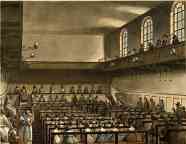In England, too, arose the great religious movements of the seventeenth and eighteenth centuries—and especially that of a body which I can never mention without most deep respect—the Society of Friends. At a time when the greater part of the Continent was sunk in spiritual sleep, these men were reasserting doctrines concerning man, and his relation to his Creator, which, whether or not all believe them (as I believe them) to be founded on eternal fact, all must confess to have been of incalculable benefit to the cause of humanity and civilisation. — Charles Kingsley, The Ancien Régime
Origins.
Founded in England in the seventeenth century by George Fox (1624-1691), the Society of Friends is a radical (pacifist) Protestant sect with roots in the period of the English revolution. Their quaint-sounding thees and thous, and their practice of keeping hats on indoors derive from George Fox's determination not to make signs of obeisance to any man, including the king. Since Quakers understand the spiritual life in entirely inward terms, they do not employ sacraments or other outward forms in worship.Inward Light.
The doctrine of the Inward Light justifies Quakers' speech as the prompting of the Spirit. As any member may be "moved by the Spirit" to witness, all members at meeting for worship are potential ministers, and Quaker women preached or spoke in meeting from early days, eliciting Dr. Johnson's remark:
Sir, a woman preaching is like a dog walking on its hind legs. It is not done well; but you are surprised to find it done at all.
More positive views of Quaker worship can be found in Charles Lamb's essay, "A Quakers' Meeting" (The Essays of Elia).
Quakers in the Eighteenth Century.
In the eighteenth century Quakers developed the style of primarily silent worship and plain living that characterizes them in the popular imagination. They grew prosperous as tradesmen, bankers, and merchants, and the fervor of early Quakerism solidified into more rigid practices, as the sect became quietist theologically, and by extension, politically.
Quakers in the Nineteenth Century

Quakers Meeting (1809).
Celebrated causes such as the abolition of slavery and prison reform made Quakers more prominent in the nineteenth century, although their membership shrank until the 1860s, when the automatic "disownment" of Friends who married non-Quakers ceased. Membership stayed near 16,000 during the Victorian period, growing very modestly towards the end of the century. Quakers' eschewing of sacraments (including baptism), their silent worship, and their extremely close-knit, well-to-do communities made conversion to membership in the Society of Friends as unusual as it was difficult to achieve.
Faith and Practice.
Unlike other Christians, Quakers do not have a creed, but they answer in quarterly meetings a set of Queries concerning their faith and practice. (Five editions of the Friends' Book of Discipline record the changes made during the Victorian period.) Queries of particular relevance to Victorian Quakers included those regarding opposition to paying church rates, bearing arms, smuggling, and slavery. Though John Bright resigned his cabinet post in 1882 in protest of the British attack on Alexandria (having opposed British policy in the Crimea three decades earlier), the peace testimony associated with twentieth-century Friends was not a prominent cause for Victorian Quakers.
Two Victorian Friends.
The evangelical revival that touched some Victorian Friends influenced the character of Quakers' philanthropic activities begun or inspired by the work of Elizabeth Gurney Fry. By far the most famous British Quaker in the Victorian period, Mrs. Fry in fact ceased her public work soon after Victoria ascended the throne. Between 1813, when she first visited the women prisoners in Newgate, and her death in 1845, Mrs. Fry earned an international celebrity. To Victorians, she was an icon of philanthropic reform, celebrated for her work with women prisoners in jails and on transportation ships, with the insane, the homeless, with prisoners on hulks, and with juvenile offenders.
In the political realm, John Bright rose to prominence as a leader of the Corn Laws Anti-Corn-Law League. Bright's opposition to legislation protecting factory workers reflects his allegiance to free trade, for he was a manufacturer and adherent of the "Manchester School" of economics, as well as an advocate of many reform causes.
Quakers and Victorian Literature
Two women writers of the Victorian period, Mary Howitt and Sarah Stickney Ellis, were raised in the Society of Friends. Mrs. Ellis, author of The Women of England (1839), converted to Congregationalism upon marriage, but remained friendly to Quakers. While editor of Fisher's Drawing Room Scrapbook, she honored Mrs. Fry. The autobiography of the poet Mary Howitt conveys many details of Quaker life in the Victorian period. F. D. Maurice employs a Quaker interlocuter as a device in his theological work, The Kingdom of Christ; or hints respecting the Principles, Constitution, and Ordinances of the Catholic Church (1838; rev. 2nd. ed 1842). Quaker characters appear in Elizabeth Gaskell's Sylvia's Lovers (1863), and Anthony Trollope makes a Quakeress his heroine in Marion Fay (1871-72).
Of the many works containing representations of Friends in American literature, Harriet Beecher Stowe's Uncle Tom's Cabin (1852) was the most widely disseminated in Victorian Britain.
Related Material
- Gender Equality in the Society of Friends (Quakers)
- What Female Members of the Society of Friends wore (1843)
Suggested Readings
Fox, George. George Fox, an Autobiography (HTML at CCEL)
Howitt, Mary. An Autobiography, edited by her daughter Margaret Howitt. 1889. AMS P, 1973.
Isichei, Elizabeth. Victorian Quakers. London: Oxford UP, 1970.
Rose, June. Elizabeth Fry. London: Macmillan, 1980.
Last modified 13 June 2021